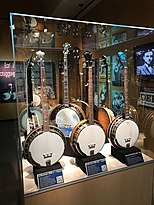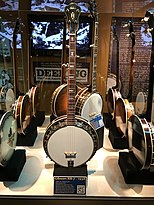Prewar Gibson banjo
Gibson manufactured banjos in the years before World War II. They are differentiated from later Gibson banjos by their scarcity. Banjo sales plummeted during the Great Depression, for lack of buyers, and metal parts became scarce into the 1940s as factories shifted to support the war.[1] As parts became scarce, non-standard versions came out, made from a variety of leftover parts, called floor sweep models.[2]
Terminology
[edit]Although this term normally refers to World War II, when used to describe Gibson banjos, the term prewar operationally refers to banjos made prior to 1947. Production of metal banjo parts was suspended during World War II.[3] However, small numbers of Gibson banjos continued to be constructed and shipped during the war years using stocks of metal parts remaining in factory bins.
Production of metal banjo parts resumed in late 1946; however, it is commonly believed that the metal composition of foundry products delivered to Gibson after World War II was inferior to that of parts produced prior to 1940.[4] On April 12, 1947, the Gibson Instrument Company changed their corporate logo from script lettering to the use of block letters, and this change occurred sufficiently close to resumption of banjo output to allow easy identification of prewar and postwar Gibson instruments.[5]
References
[edit]- ^ Lastelick, Luke (7 December 2022). "Pre-War Gibson Banjos - A Global Gold Standard". The Roundup. Retrieved 5 June 2023.
- ^ Gibson RB-4 - 1929 (Plaque beneath museum exhibit). Oklahoma City, OK: American Banjo Museum.
banjo differs from typical Gibson production in 1929 and was completed in 1930s from parts found around the Gibson factory - a 'floor sweep' model
- ^ Waldrep, Barry (26 January 2016). "Gibson Banjos for Sale". Banjo.com. Retrieved 5 June 2023.
- ^ Wathen, Chris (8 December 2022). "Original Five-String Flathead Prewar Gibson Banjos". Bluegrass Unlimited. Retrieved 5 June 2023.
- ^ Makuch, Cole (23 September 2016). "How to Date a Gibson Using Serial Numbers, FONs and Logos". Reverb. Retrieved 5 June 2023.
Further reading
[edit]- Spann, Joseph E. (2011). Spann's Guide to Gibson 1902–1941. Centerstream Publications.
External links
[edit]- Earnest Banjo--Prewar Gibson Mastertone Banjos
- Chronology of Gibson Banjos
- Identifying a Gibson Banjo
| Technique | |
|---|---|
| Family instruments | |
| Genres | |
| People | |
| Manufacturers | |
| International variants | |
| Key figures | |||||||||||||
|---|---|---|---|---|---|---|---|---|---|---|---|---|---|
| Guitars |
| ||||||||||||
| Basses |
| ||||||||||||
| Other products | |||||||||||||
| Subsidiaries | |||||||||||||
| Brands | |||||||||||||
Text is available under the CC BY-SA 4.0 license; additional terms may apply.
Images, videos and audio are available under their respective licenses.



